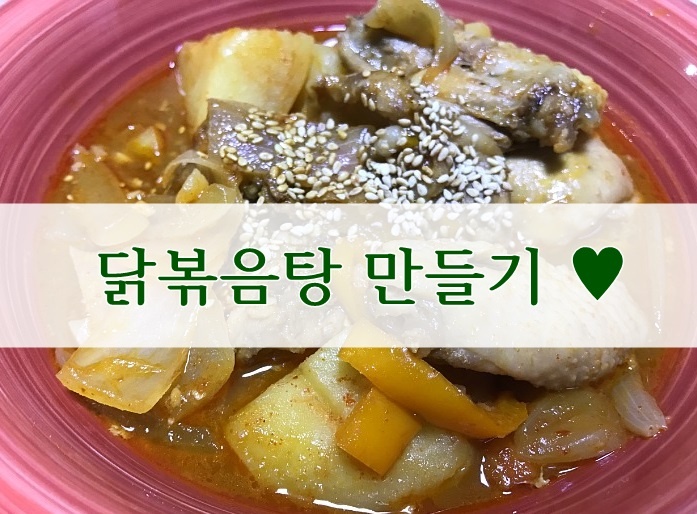Spicy and Sweet Delicious Dakbokkeumtang Recipe
Homemade Dakbokkeumtang: The Golden Recipe for Restaurant-Quality Flavor!

This recipe uses pre-cut chicken from the freezer to create a delicious Dakbokkeumtang (Korean spicy braised chicken) that anyone can easily make. Properly cooked, it’s a safe and incredibly tasty chicken dish! Let’s get started.
Main Ingredients for Dakbokkeumtang- 1 whole chicken (cut into pieces)
- 2-3 potatoes
- 1/3 carrot
- 1 onion
- 1 bell pepper
- 1/2 stalk of green onion
- 2 Korean chili peppers (cheongyang gochu)
- 600ml water
Flavor-Enhancing Seasoning Ingredients- 3 Tbsp sugar
- 3-4 Tbsp gochujang (Korean chili paste)
- 4 Tbsp gochugaru (Korean chili flakes)
- 9 Tbsp soy sauce
- 1 Tbsp minced garlic
- 2 Tbsp oligosaccharide (or corn syrup)
- 2 Tbsp rice wine (mirin or soju)
- 3 Tbsp sugar
- 3-4 Tbsp gochujang (Korean chili paste)
- 4 Tbsp gochugaru (Korean chili flakes)
- 9 Tbsp soy sauce
- 1 Tbsp minced garlic
- 2 Tbsp oligosaccharide (or corn syrup)
- 2 Tbsp rice wine (mirin or soju)
Cooking Instructions
Step 1
First, thoroughly wash all the vegetables that will enhance the flavor of your Dakbokkeumtang. Then, cut them into bite-sized pieces. Cut the potatoes, onion, and carrot into larger chunks, and slice the green onion and Korean chili peppers diagonally.

Step 2
Now, let’s make the key seasoning for a delicious Dakbokkeumtang! The measurements in the recipe are a guideline. Please adjust them based on the saltiness and spiciness of your gochujang, gochugaru, and soy sauce at home. For example, in my household, the gochujang from my mother-in-law and the store-bought gochugaru are quite spicy, and the soy sauce is on the saltier side. So, I made the sauce using 4 Tbsp gochujang, 4 Tbsp gochugaru, 7 Tbsp soy sauce, 1.5 Tbsp minced garlic, 2 Tbsp oligosaccharide, and 2 Tbsp rice wine. Adjust these to your taste to create a wonderful seasoning blend!

Step 3
Rinse the chicken pieces under cold running water. If the chicken doesn’t seem very fresh, you can soak it in milk for about 30 minutes to remove any gamey smell and tenderize it further.

Step 4
Prepare 600ml of water as the base for the Dakbokkeumtang broth. However, since I like to add more vegetables, I used about 700ml of water. Adjust the amount of water based on how many vegetables you’re using.

Step 5
Place the chicken in a deep pot. Add the sugar to the boiling water. Adding sugar early in the cooking process is said to help the chicken absorb the flavors more effectively, enhancing its deliciousness.

Step 6
As the chicken starts to boil, skim off any impurities (scum) that rise to the surface and discard them. This step ensures that your Dakbokkeumtang broth will be clean and have a refreshing taste.

Step 7
When the chicken is about halfway cooked, add the prepared potatoes and carrots. Adding the firmer vegetables first helps ensure they cook evenly with the rest of the ingredients.

Step 8
Pour all the prepared seasoning mixture into the pot. Mix well to ensure the sauce coats the chicken and vegetables evenly. Let it simmer over medium heat so the flavors can meld beautifully.

Step 9
Once the potatoes are somewhat tender, add the onion, Korean chili peppers, and bell pepper. These vegetables cook quickly, so adding them towards the end preserves their fresh texture and vibrant color.

Step 10
Finally, sprinkle the chopped green onions on top for a beautiful garnish. The fragrant green onions will further enhance the overall flavor of the Dakbokkeumtang.

Step 11
Now, let all the ingredients meld together. Simmer on low heat until the sauce has deeply penetrated the chicken and vegetables. Basting occasionally with the sauce will make it even more delicious. Your flavorful Dakbokkeumtang is ready!

Step 12
Your hearty and appetizing Dakbokkeumtang is complete! Enjoy it with a warm bowl of rice.




